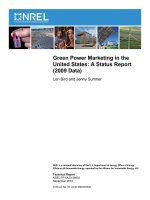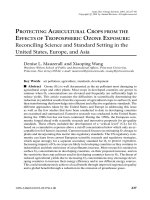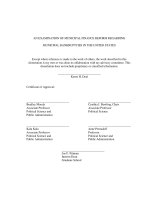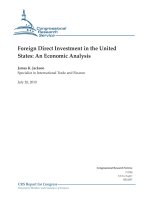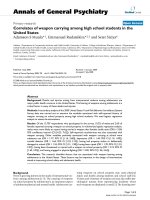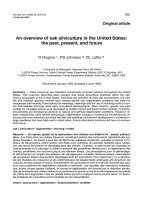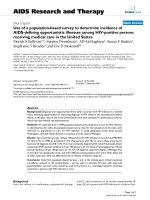metaphor in the declaration of independence of the united states = ẩn dụ trong tuyên ngôn độc lập của mỹ
Bạn đang xem bản rút gọn của tài liệu. Xem và tải ngay bản đầy đủ của tài liệu tại đây (705.88 KB, 75 trang )
VIETNAM NATIONAL UNIVERSITY, HANOI
UNIVERSITY OF LANGUAGES AND INTERNATIONAL STUDIES
FACULTY OF POST-GRADUATE STUDIES
NGUYỄN THỊ THANH BÌNH
METAPHOR IN THE DECLARATION OF
INDEPENDENCE OF THE UNITED STATES.
(Ẩn dụ trong Tuyên ngôn độc lập của Mỹ)
M.A. Minor Thesis
Field: English Linguistics
Code: 60.22.15
Supervisor: Nguyễn Hương Giang M.A
HANOI, 2012
iv
TABLE OF CONTENTS
Table of contents vii
INTRODUCTION
1. Rationale 1
2. Aims of the study 1
3. Scope of the study 2
4. Methods of the study 2
5. Design of the study . 3
DEVELOPMENT
Chapter 1: An overview on Metaphor 4
1.1. Definitions of Metaphor 4
1.2. Components of Metaphor 5
1.3 Classification of conceptual metaphor 7
1.3.1 Ontological metaphor 8
1.3.1.1 Container metaphor 9
1.3.1.2. Substance metaphor 10
1.3.1.3. Entity metaphor 10
1.3.2. Orientiational metaphor. 11
1.3.3. Structural metaphor 13
1.4 Functions of Metaphor 15
1.4.1 Metaphor is used to create image 15
v
1.4.2 Stylistic hypothesis: Metaphor has the functions of decorating 17
1.4.3. Cognitive hypothesis: Metaphor has the function of enabling cognition . 17
CHAPTER 2: THE STUDY
2.1. Research questions 19
2.2. Data collection 19
2.3. Analytical framework 19
2.4. Data analysis and discussion 20
2.4.1 Ontological metaphor 22
2.4.2 Structural metaphor 34
2.4.3 Orientational metaphor 34
CONCLUSION
1. Major findings 37
2. Implications 38
3. Suggestions for further studies 39
REFERENCES 40
APPENDIX ix
1
ABBREVIATIONS USED IN THE THESIS
1. Sub.Met: Substance metaphor
2. Ent.Met: Entity metaphor
3. Con.Met: Container metaphor
4. Per.Met: As person metaphor
5. Obj.Met: As object metaphor
6. Ort.Met: Orientational metaphor
7. Str.Met: Structural metaphor
2
LIST OF TABLES AND CHARTS
Table 1: Conceptual metaphors in the Declaration of Independence
Table 2: Ontological metaphors in the Declaration of Independence
Chart 1: The percentage of conceptual metaphor in the Declaration of Independence
3
INTRODUCTION
1. Rationale
Metaphor is one of the most complex and powerful tools of language and hence
gets a section all to itself. It is widely used in different types of text like literature, science,
journals, advertisement, religion, politics or everyday language. The use of metaphor as a
part of figurative language aims to help the listeners to visualize what is meant by a phrase
or expression. It is seen everyday and every time by almost everybody. In fact, politicians
use language to persuade people that their thoughts, aims and ideas are equitable and to
make their point clear and vivid to the people. It is proved that the use of metaphor is one
of the most prominent tools for persuasion and an effective instrument for propaganda in
political language. Commenting on the important role of metaphor, George Lakoff and
Mark Johnson (1980:3) state that ―metaphor is pervasive in everyday life, not just in
language but in thought and action‖
The Declaration of Independence is delivered to announce independence and
sovereignty of any countries to not only their citizens but also other countries in all over
the world. Therefore, its author has to use rhetorical strategies to convince people and
metaphor is one of the rhetorical strategies which are found to be commonly used. Thus, I
would like to conduct a study on the use of metaphor in the Declaration of Independence of
the United States to find out what types of metaphor are commonly used and how effective
they are.
2. Aims of the study
This study was conducted to fulfil the following aims:
4
To provide knowledge about conceptual metaphor from Lakoff and Johnson‘s
perspective
To investigate the use of conceptual metaphor in the Declaration of Independence
of the United States
To give suggestion on some teaching and learning activities to gain more
understanding about metaphor.
These aims of the study were achieved via the following research questions:
What is conceptual metaphor?
How many types of conceptual metaphor are there?
What types of conceptual metaphor are used in The Declaration of
Independence of the United States?
3. Scope of the study
This study attempts to look at theories of metaphor. Cognitive theory about
metaphor developed by Lakoff and Johnson will be presented in details in terms of
definition, components, classification and functions. Then, the Declaration of
Independence of the USA is analysed using Lakoff and Johnson‘s theory to figure out
typical conceptual metaphors in this writing.
4. Methods of the study
The study is carried out mainly based on the combination of both descriptive and
explanatory methods. These two methods were used to collect data different books and
other sources available, describe the collected information and analyze the Declaration of
Independence of the USA. The study was conducted as follows:
5
Firstly, data was collected from different books, websites about metaphor in
English.
Secondly, the collected information was synthesized and categorized
Finally, the Declaration of Independence was analyzed in terms of metaphor.
5. Design of the study
The study consists of 3 main parts: Introduction, Development and Conclusion.
The Introduction presents the rationale, aims, scope, methods and design of the
study.
The Development is divided into 2 chapters. Chapter 1 deals with theoretical
background of the study including different theories of metaphor. Chapter 2 accounts for
the study of conceptual metaphors used in Declaration of Independence of America.
The Conclusion focuses on major findings, implications and suggestions for further
studies.
6
DEVELOPMENT
CHAPTER 1: AN OVERVIEW OF METAPHOR
1.1. Definitions
Metaphor, one of the most important and widespread figures of speech, has been
given a lot of definitions. Historically, the word ―metaphor‖ is originated from the Greek
word ―metapherin‖ which means ―to carry something across‖ or ―to transfer‖, is normally
used to refer to the method of comparing two different items based on resemblance or
similarity. Form Aristotle‘s point of view, metaphor is based on ―seeing resemblances‖ in
things. According to Aristotle, metaphor is defined as a ―transfer of a name belonging
elsewhere‖ (cited in Lessengberg, 2001:33). However, his definition of metaphor is
merely at the level of words and later authors make more extensive study about the nature
of metaphor.
In ―A handbook to Literature‖ by Harmon and Homan (ed, 1996:315), metaphor is
defined as ―an analogy identifying one object with another and ascribing to the first object
one or more of the qualities of the second‖. In this definition, metaphor is seen as the
process of expressing one thing through another thing due to the similarities of two objects.
Sharing the same view, a definition offered by Cambridge Advanced Learner‘s
Dictionary considers metaphor as ―an expression which describes a person or object in a
literary way by referring to something that is considered to possess similar characteristics
to the person or object you are trying to describe‖.
Two authors who are largely well-known for their study of metaphor are Lakoff
and Johnson with their book ―Metaphor We live by‖. In this book, metaphor is defined as a
process by which we conceive ―one thing in terms of another, and its primary function is
understanding‖ (Lakoff and Johnson, 1980:36). These authors consider metaphor as the
interaction between a source domain and a target domain in the conceptual process rather
7
than the interaction between two words only. Thus, metaphor from the perspective of
Lakoff and Johnson also called conceptual metaphor.
Obviously, these definitions meet one another at a point that they all regard
metaphor as the description or conception of one object in terms of another due to some of
their similar qualities. Besides, metaphor is not only a common device used in language
but also an important process concerning human‘s cognition about the world.
1.2. Components of metaphor
According to I.A. Richards (1936), metaphor consists of two main parts: tenor and
vehicle which are relatively called target and source by Lakoff and Johnson (1980). Tenor
is the thing that the metaphoric word or phrase refers to whereas vehicle is the metaphoric
word or phrase. In ―A Handbook to Literature‖ by Harmon and Homan (eds, 1996: 315), it
is said that ―the tenor and vehicle taken together constitute the figure, trope, or ―turn‖ in
meaning that the metaphor conveys. At one extreme, the vehicle may be merely a means of
decorating the tenor, at the other extreme, the tenor may be merely an excuse for having
the vehicle.‖ Thus, between them always exists a close relation and similarity that may be
very obvious or only in the mind of the metaphor maker.
For example:
“Mary is a blooming rose”
In this metaphor, ―Mary‖ is the tenor and ―a blooming rose‖ is the vehicle. It can be
seen in this example that there must be certain similar features between ―Mary‖ and ―a
blooming rose‖. The maker of the metaphor implies that the beauty and vitality of Mary
can be described as a blooming rose in the spring.
Mary is
a blooming rose
8
In order to show the relationship between tenor and vehicle, the most popular way
is to use a linking verb between them. However, sometimes there is no existence of the
linking verb and even the tenor but the metaphor still can be implied through the vehicle.
For example, in this sentence ―Bee! I‘m expecting you‖ from a poem Dickinson (1924:23),
we can see that there is no attendance of the tenor here but the tenor ―somebody dearest‖ of
the poet can be implied through the vehicle ―bee‖.
Besides tenor and vehicle, another important part of metaphor is also mentioned in
a lot of researches. The term is called ―dimension‖ or ―‖ground Richards (1936) which is
defined as the quality that one refers to when using a particular vehicle in relation to the
tenor. The vehicle has a number of dimensions which may be mapped or transferred back
onto the tenor and hence create new meaning. For example, the poem ―Fame is a bee‖ (
Dickinson, 1924:23) suggests a number of dimensions between the tenor ―fame‖ and the
vehicle ―bee‖ such as the happiness and the pain that both fame and a bee can bring to
human.
For example:
Fame is a bee - 1763
Fame is a bee.
It has a song—
It has a sting—
Ah, too, it has a wing.
(Emily Dickinson)
According to Lakoff and Johnson, metaphor is seen as a cognitive mechanism
whereby one conceptual domain is partially mapped onto a different conceptual domain.
The second domain is partially understood in term of the first one with the linguistic
metaphor deriving from those domains.
9
The domain that is mapped is called the source domain/ donor domain.
The domain onto which it is mapped is target domain/ recipient domain.
E.g. Argument is war
Argument: target domain
War: source domain
(Lakoff & Johnson, 1980)
In short, it can be inferred that through vehicle and dimension or ground, tenor can
be expressed implicit and this complete process is able to create a metaphor.
1.3. Classifications of Conceptual metaphor
There are a number of ways to classify metaphor depending on different criteria
and hypothesis. The classification of it can be conducted in terms of functions,
grammatical features, linguistics characteristics, popularity, etc.
Leezengberg (2001:3) distinguishes linguistic metaphors from nonlinguistic ones.
He states that: ―linguistic metaphors typically involve a much more elaborate ‗code‘ that
nonlinguistic ones‖. According to his theory, linguistic metaphors are simply reflections of
more general cognitive process.
According to Wikipedia, there is a detailed and clear classification of metaphor
collected and synthesized. Metaphors are classified into Absolute metaphor, Active
metaphor, Complex metaphor, Compound metaphor, Concrete metaphor, Dead metaphor,
Dormant metaphor, Dying metaphor, Extended metaphor, Implicit metaphor, Mixed
metaphor, Pataphor, Root metaphor, Simple metaphor, Submerged metaphor and
Synechdochic metaphor.
Lakoff and Johnson classify metaphor into three main types including ontological,
orientational and structural metaphor.
10
1.3.1 Ontological metaphor
Lakoff and Johnson reasoned that ontological metaphors occurred when our
experience of physical object and substances provided a further basis for understanding.
This means that we understand many abstract experiences (such as events, activities,
emotions and ideas) in terms of concrete substance, object and processes. Therefore,
ontological metaphors involve ways of viewing intangible concepts as entities. Identifying
these abstract and indefinable non-entities as substances or entities make it possible, too
―refer them, categorize them, group them, and quantify then – and by this means reason
about them‖ (Lakoff and Johnson, 1980:25). One thing to notice is that because most
ontological metaphors are so fundamental to our thought and language, they are not often
identified as metaphors anymore. Therefore, for example, expressions of ontological
metaphor WEALTH IS A HIDDEN OBJECT in everyday language is not considered
metaphor by most people.
He‟s seeking his fortune
He‟s flaunting his new found wealth.
He‟s a fortune hunter.
She‟s a gold digger.
He lost his fortune.
He‟s searching for health.
(Lakoff & Johnson, 1980)
As ―seek‖, ―search for‖, ―found‖, ―lost‖ are quite familiar, people do not think
them as metaphors. However, they are metaphors in fact and they help us understand
―wealth‖, an abstract concept more easily and more clearly.
In short, ontological metaphors help us to represent an abstract thing in terms of
something concrete such as an object, substance, container or person. In more details,
11
ontological metaphor is subdivided into container metaphor, substance metaphor and
entity metaphor.
1.3.1.1.Container metaphor
Container metaphor is an ontological metaphor in which some concept is
represented as
- having something inside and outside
- being capable of hiding something else
This means that non-physical objects are transformed into physical objects with
define boundaries. Examples of this kind of metaphor are shown in expressions of
metaphor LIFE IS A CONTAINER.
I‟ve had a full life.
Life is empty for him.
There‟s not much left for him in life.
His life is scrammed with activities.
Get the most out of life.
His life contained a great deal of sorrow.
Live your life to the fullest.
(Lakoff & Johnson, 1980)
1.3.1.2. Substance metaphor
Substance metaphor is an ontological metaphor in which an abstraction such as an
event, activity, emotion or idea is represented as material substance. Examples of this kind
of metaphor can be shown in expressions of metaphor VITALITY IS SUBSTANCE.
She‟s brimming with vim and vigor.
She‟s overflowing with vitality
He‟s devoid of energy
12
I don‟t have any energy left at the end of the day.
I‟m drained.
That took a lot out of me.
(Lakoff & Johnson, 1980)
1.3.1.3. Entity metaphor
Entity metaphor is created when an abstraction is presented as a concrete physical
object. The following expressions are examples of metaphor LOVE IS A PHYSICAL
FORCE (ELECTROMAGNETIC, GRAVITATIONAL, ETC.)
I could feel the electricity between us.
There were sparks.
I was magnetically drawn to her.
They are uncontrollably attracted to each other.
They gravitated to each other immediately.
The atmosphere around them is always charged.
(Lakoff & Johnson, 1980)
A subtype of entity metaphor is personification in which a thing or abstraction is
represented as a person. Here, human characteristics are imposed on inhuman experiences.
For example
His relation tells him he can‟t drink wine.
Here, religion is personified as a person who tells other people to do something.
In short, ontological metaphor is a metaphor in which an abstraction such as an
activity, an emotion, state or idea is represented as something concrete such as an object,
substance, container or a person.
1.3.2. Orientiational metaphor.
13
Orientiational metaphor is a metaphor in which concepts are spatially related to
each other. Orientational metaphor organizes a whole system of concepts with respect to
another. Orientational metaphor explains a concept in terms of space of ―give a concept a
spatial orientation‖ (Lakoff and Johnson, 1980:15). Most of Orientational metaphor relate
to spatial orientation such as up-down, in-out, deep-shallow, on-off, central-peripheral.
There are some popular orientational metaphor such as Happy is up, sad is down; More is
up, less is down; Concious is up, unconcious is down; and Good is up, bad is down. The
examples below are used to support for these metaphors.
Orientational metaphors are not arbitrary. They have a basis in our physical and
cultural experience. Followings are some common orientational metaphors:
Example 1. HAPPY IS UP, SAD IS DOWN
I‟m feeling up, to day
He‟s really low these days.
(Kovecese, 2010: 30)
These metaphors are created on the basis that drooping posture typically goes
along with sadness and depression while erect posture often goes with a positive emotional
state.
Example 2. MORE IS UP, LESS IS DOWN.
Speak up, please
Keep your voice down, please
(Kovecese, 2010: 30)
These metaphors are based on physical experience, that is if we add more
substance of physical subject to a container or pile, the level goes up.
Example3. CONSCIOUS IS UP, UNCONSCIOUS IS DOWN.
14
Wake up. He rises early in the morning.
He fell asleep. He dropped off to sleep. He‟s under hypnosis. He sank into a coma.
(Kovecese, 2010:31)
The physical basis of these metaphors is that human and other mammals in general
lie down when they sleep and stand up when they awaken.
Example 4. GOOD IS UP, BAD IS DOWN
Things are looking up. We hit a peak last year, but it‟s been downhill ever since.
Things are at an all-time low. He does high-quality work.
(Kovecese, 2010: 31)
The physical basis of these metaphors is that positive things are often associated
with high position while negative things are often associated with low position.
Although the polar oppositions are physical in nature, the orientations metaphors
based on them are not always the same form culture to culture.
Lakoff and Johnson emphasize the importance of orientational metaphor
―specialization is so essential a part of a concept that is difficult for us to imagine any
alternative metaphor that might structure the concept‖ (Lakoff and Johnson, 1980:19)
Moreover, Orientational metaphors do not simple structure our thinking about one
concept but they structure our thinking about systems of concepts. For example, GOOD is
UP gives an UP orientation to general well-being, and this orientation is coherent with
special cases like HAPPY IS UP, ALIVE IS UP, HEALTH IS UP, and CONTROL IS UP.
1.3.3. Structural metaphor
Structural metaphors are said to be the biggest group of metaphorical concepts.
They concern characterizing the structure of a concept by comparing it to the structure of
another concept. In other words, a structural metaphor is created when one concept is
understood in terms of another structured, sharply defined concept. According to Lakoff
15
and Johnson, structural metaphors are considered the most complex type of conceptual
metaphor because they require readers and hearers to transfer one basic domain of
experience to another basic domain. This process is called ―a cross-domain mapping in the
conceptual system‖ The mapping happens between the source domain and the target
domain. For example, the structural metaphor LIFE IS A JOURNEY will consist of a
source domain (journey) and a target domain (life) and a mapping between these domains
(the person leading a life correspond to traveler; the life goals correspond to destination on
the journey; difficulties in life correspond to impediments to travel). Thus, the following
picture shows some common things between LOVE and JOURNEY and these expressions
are examples of this metaphor.
Lakoff and Johnson’s conceptual metaphor LOVE IS A JOURNEY (or the
LOVE AS JOURNEY MAPPING). Cf. Lakoff and Johnson (1980)
Examples:
He‟s got a head start in life. He‟s without direction in his life.
I‟m at a crossroads in my life.
He‟ll go places in life.
He‟s never let anyone get in his way.
Source domain
JOURNEY
travelers
vehicle
destination
impedements
Target domain
LOVE
lovers
love relationship
comman goals
difficuties
Mapping
16
(Lakoff & Johnson, 1980)
This kind of metaphor is embedded in the conceptual framework of our culture.
This mean that structural metaphors are results of how we view the world around us.
In summary, Lakoff and Johnson‘s contributions play an important role in the
development of cognitive theory about metaphor. Their theory about conceptual metaphor
has been the basis for a number of studies on metaphor. An analysis of metaphors used in
Declaration of Independence of USA will be clearly presented in the next chapter.
1.4 Functions of Metaphor
As mentioned above, metaphor plays an important part not only in language but
also in human cognition. Lakoff and Johnson (1980: 239) assert that ―metaphor is as much
a part of our functioning as our sense of touch, and as precious‖. The nature and functions
of metaphor are studied by a lot of linguists and researchers in different fields such as
science, linguistic philosophy, psychology, sociology and anthropology, literature and
translation. Metaphor has some certain functions, one of which is to create image. Besides,
two main hypotheses concerning the decorative and cognitive functions of metaphor are
stylistic and cognitive ones.
1.4.1 Metaphor is used to create image
Being an important part in poetry, image has the function to fill the spaces made in
the rhetorical moves of poem. That means it plays the role of a concrete subject to stand for
abstract things. Therefore, metaphor and other figures of speech mostly involve images. As
a result, one major function of metaphor is creating images for abstract concepts.
The notion ―image‖ has been studied for thousands of years, by both philosophers
and poets. A lot of definitions have been made with the effort to make clear about the
nature and the use of it in language. A definition is offered by Oxford Advanced Learner‘s
17
Dictionary, in which image is defined as ―a word or phrase used with a different meaning
form its normal one, in order to describe something in a way that produces a strong picture
in the mind‖. However, this definition only covers the basic understanding about an image
but not the real nature of an image. One of the most widely used definitions of image that
comes from Ezra Pound (1913:3) states that ―an image is that which represents an
intellectual and emotional complex in an instant of time‖. In this definition, image is not
only a representative of something else but also a representative of emotion, intellect and
other concrete things that human being can experience in a particular point of time.
There are two kinds of images: literal and figurative images. Literal images appeal
to our sense of realistic perception whereas figurative images appeal to our imagination.
Thus, an image in poetry is not only visual as an ordinary image but it can also engage any
of the sense. For these characteristics of an image, metaphor often employs image to make
abstract notions easier to be recognized. For example, ―Life is a journey‖ is a metaphor in
which the concept ―life‖ can be expressed condensed and exactly through the image ―a
journey‖. Hence, everybody can understand that life is a long journey that passes a lot of
ups and downs like success, happiness, difficulty and pain as well. As can be seen, this
metaphor has created a concrete image ―a journey‖ for an abstract notion as ―life‖
The relationship between metaphor and image is close but of course they are not
one. According to Masako (2005:31), images are ―those which partake of simple qualities,
of First Firstness‖ while metaphors are ―those which represent the representative character
of a representative by representing a parallelism in something else‖. Moreover, he asserts
that images can be recognized by anyone but it is not an easy task to recognize the
figurative meaning of a metaphor.
Besides images, another related term is imagery which is considered to lie at the
heart of a poem. Sometimes, in order to extend the description of the subject matter,
metaphor can create not only one image but a network of different images. Imagery, that
18
means images take collectively, is defined as ―the total sensory suggestion of poetry‖
(John Ciardi, World Book Dictionary
According to Arbrams (ed, 1985), imagery has three main functions. Firstly, it is used to
―signify all the objects and qualities of sense perception referred to in a poem or other
work of literature, whether by literal description, by allusion, or in the analogues (the
vehicles) used in its similes and metaphors‖ (Abrams, ed, 1985: 81). Secondly, it is
employed to signify only description of visible objects and scenes. Thirdly, the most
common use of imagery is to signify figurative language, especially the vehicles of
metaphors and similes.
As can be seen, image and imagery are essential parts of a poem and they make
poetry more concrete. With them, it is possible for creative writers to develop the function
of metaphors that is to create concrete images so as to explain abstract concepts as well as
bring aesthetic effects to their works of art.
1.4.2 Stylistic hypothesis: Metaphor has the function of decorating
Stylistic hypothesis is the one that assumes the metaphorical language to be
motivated primarily by stylistic considerations. It means that this hypothesis regards
metaphor as an extraordinary use of language with the view to achieving particular
aesthetic effects. Thus, metaphor has got a prominent function that is to decorate or
ornament something. Carrying this outstanding function, metaphor is commonly found in
creative writing such as poetry, literature, public oratory and other registers.
1.4.3. Cognitive hypothesis: Metaphor has the function of enabling cognition
On the contrary, cognitive hypothesis regards metaphor as a pervasive feature of
everyday English. Metaphors, for Lakoff and Johnson who most contribute to cognitive
hypothesis of metaphor, are primarily matters of thought and actions, only derivatively of
language. In stead of discussing its function in language only, the authors of cognitive
hypothesis view metaphor as a conceptual phenomenon with the function to help human
19
―understanding and experiencing one kind of thing in terms of another‖ (George Lakoff
and Mark Johnson, 1980: 5). In the view point of cognitive hypothesis, the main function
of metaphor is to enable human to grasp meanings of abstract notions via more concrete
ones. In fact, metaphor can be employed in mangy different kinds of discourse, not only in
creative ones like literature or poetry. For instance, metaphor can be found in science, is
not merely to decorate something but more importantly to enable us to conceive one
abstract concept in terms of another concrete subject.
CHAPTER 2: THE STUDY
20
2.1. Research questions
The study was conducted to answer the following question:
What types of conceptual metaphor are used in the Declaration of
Independence of USA?
2.2. Data collection
Data were collected from the Declaration of Independence of USA. It is
divided into five main sections: the introduction, the preamble, the indictment of
George III, the denunciation of the British people and the conclustion. Each section
will be studied in details to figure out which types of conceptual metaphors are
used and how they effected to audience.
2.3. Analytical framework
The analytical framework used in this study is based on classical cognitive
theory of metaphor by Lakoff and Johnson and in terms of speech part as follows
Conceptual metaphors
Kinds of conceptual
metaphor
Description
Examples in Declaration of
Independence
1. Ontological
metaphor.
Con.Met
Non-physical objects are
transformed into physical
objects with define
boundaries
1. He has kept among us, in
times of peace, standing
Armies without Consent of
our legislatures.
2. For abolishing the free
System of English Laws in
a neighbouring Province
Sub.Met
An abstraction such as an
event, activity, emotion or
Prudence, indeed,
will dictate that
21
idea is represented as a
material substance.
Governments long
established should not be
changed for light and
transient causes ”
Ent.Met
An abstraction is
represented as a concrete
physical object or a person
Potitical bands is object
When in the Course of human
events it becomes necessary
for one people to dissolve the
political bands which have
connected them with
another
2.Orientational metaphor
Concepts are spatially
related to each other.
Good is up, bad is down
it is the Right of the People to
alter (Ori.Met) or to abolish
(Ori.Met) it, and to institute
new (Ori.Met) Government
3. Structural metaphor
One concept is understood
in term of another
structured, sharply defined
concept.
causes as origin
declare the causes which
impel them to the separation.
light and transient causes
2.4. Data analysis and discussion
In the following section, the Declaration of Indendence is analyzed in terms of
ontological metaphor, structural metaphor and orientation metaphor from Lakoff and
Johnson‘s perspective. In term of meaning interpretation, only metaphors which are used
22
twice or more and can created emotional effect on the audience are discussed. The others
metaphors are listed in the appendices.
Types of metaphor
Ontological
metaphors
Structural
metaphors
Orientational
metaphors
Number of
metaphors
74
3
2
Table 1: Conceptual metaphors in the Declaration of Independence
Table 1 describes the number of conceptual metaphors including ontological
metaphors, structural metaphors and orientations metaphor. As can be seen, ontological
metaphors are used with the highest frequency (74 metaphors). Or Orientational metaphors
are employed with the smallest number (2 metaphors). Thus, the next part will deal with
the analysis of conceptual metaphors with the following order. Ontological metaphors with
the biggest number will be discussed in details first. Secondly, structural metaphors are
interpreted. Lastly, orientational metaphors with the smallest number will be briefly
discussed.
74, 93%
3, 4%
2, 3%
Ontological
Structural
Orientational
Chart 1: The percentage of conceptual metaphor in the Declaration of
Independence


